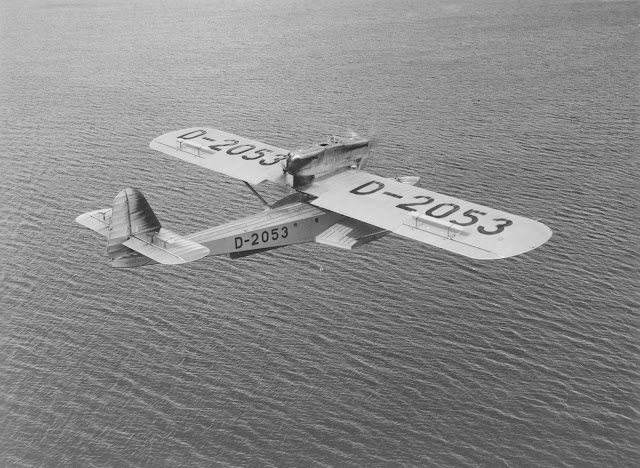"The Do J was a fairly modern (compared to those models of World War I), design with a high-mounted strut-braced monoplane wing. Two piston engines were mounted in tandem in a nacelle above the wing and in line with the hull; one engine drove a tractor and the other drove a pusher propeller. The Do J made its maiden flight on 6 November 1922. The flight, as well as most production until 1932, took place in Italy because of the restrictions on aviation in Germany after World War I under the terms of the Treaty of Versailles. Dornier began to produce the Wal in Germany in 1931, production went on until 1936.
In the military version (Militärwal in German), a crew of two to four rode in an open cockpit near the nose of the hull. There were one MG-position in the bow in front of the cockpit and one to two amidships. Beginning with Spain, military versions were delivered to Argentina, Chile and the Netherlands for use in their colonies; examples were also sent to Yugoslavia, the Soviet Union and to the end of production Italy and Germany. The main military users, Spain and the Netherlands, manufactured their own versions under licence. Several countries, notably Italy, Norway, Portugal, Uruguay, Great Britain and Germany, employed the Wal for military tasks.
The civil version (Kabinenwal or Verkehrswal) had a cabin in the nose, offering space for up to 12 passengers, while the open cockpit was moved further aft. Main users of this version were Germany, Italy, Brazil and Colombia.
The Do J was first powered by two 265 kW (355 hp) Rolls-Royce Eagle IX engines. Later versions used nearly every available engine on the market from makers like Hispano-Suiza,Napier & Son, Lorraine-Dietrich, BMW, and even the US-built Liberty Engine. The 10 to-Wal used by Deutsche Lufthansa for their mail service across the South Atlantic from 1934 to 1938 had a range of 3,600 km (2,200 mi), and a ceiling of 3,500 m (11,480 ft).
Over 250 Wals were built by CMASA and Piaggio in Italy, CASA in Spain, Kawasaki in Japan, Aviolanda in the Netherlands and Dornier in Germany.
Numerous airlines operated Wals on scheduled passenger and mail services with great success. The source Robert L. Gandt, in 1991, (pages 47–48) lists the following carriers: SANA and Aero Espresso of Italy; Aero Lloyd and Deutsche Luft Hansa of Germany; SCADTA of Columbia; Syndicato Condor of Brazil; Nihon Koku Yuso Kaisha of Japan. According to Nicolaou,1996 the Dornier Wal was "easily the greatest commercial success in the history of marine aviation".
The Colombian Air Force used Wals in the Colombia-Peru War in 1932-1933.
The Norwegian polar explorer Roald Amundsen accompanied by Lincoln Ellsworth, pilot Hjalmar Riiser-Larsen, and three other team members used two Dornier seaplanes in his unsuccessful attempt to reach the North Pole in 1925. His two aircraft, N-24 and N-25, landed at 87° 44' north. It was the northernmost latitude reached by any aircraft up to that time. The planes landed a few miles apart without radio contact, yet the crews managed to reunite. One of the aircraft, the N-24, was damaged. Amundsen and his crew worked for over three weeks to prepare an airstrip to take off from the ice. They shoveled 600 tons of ice while consuming only one pound (454 g) of daily food rations. In the end, six crew members were packed into the N-25. Riiser-Larsen took off, and they barely became airborne over the cracking ice. They returned triumphant when everyone thought they had been lost.
On 18 August 1930, Wolfgang von Gronau started on a transatlantic flight in the same Dornier Wal (D-1422) Amundsen had flown, establishing the northern air route over the Atlantic, flying from Sylt (Germany)-Iceland-Greenland-Labrador-New York 4,670 mi (7,520 km)) in 47 flight hours. In 1932 von Gronau flew a Dornier Wal (D-2053) called the "Grönland Wal" (Greenland Whale) on a round-the-world flight.
In 1926 Ramón Franco became a national Spanish hero when he piloted the Plus Ultra on a trans-Atlantic flight. His co-pilot was Julio Ruiz de Alda Miqueleiz; the other crew members were Teniente de Navio (Navy Lieutenant) Juan Manuel Duran and the mechanic Pablo Rada. The 'Plus Ultra' departed from Palos de la Frontera, in Huelva, Spain on 22 January and arrived in Buenos Aires, Argentina on 26 January. It stopped over at Gran Canaria, Cape Verde, Pernambuco, Rio de Janeiro and Montevideo. The 10,270 km journey was completed in 59 hours and 39 minutes.
The event appeared in most major newspapers world wide, although some of them underlined the fact that the airplane itself, plus the technical expertise were foreign. Throughout the Spanish-speaking world, the Spanish aviators were wildly acclaimed, particularly in Argentina and Spain where thousands gathered at Plaza de Colón in Madrid.
In 1929 Franco attempted another trans-Atlantic flight, this time crashing the airplane in the sea near the Azores. The crew was rescued days later by the aircraft carrier HMS Eagleof the British Royal Navy.
The Portuguese military aviator Sarmento de Beires and his crew made the first night aerial crossing of the South Atlantic in a Dornier J named Argos. The crossing was made on the night of 17 March 1927 from Portuguese Guinea to Brazil.
Two Dornier Wals (D-ALOX Passat and D-AKER Boreas) also played an important role in the Third German Antarctic Expedition of 1939."







